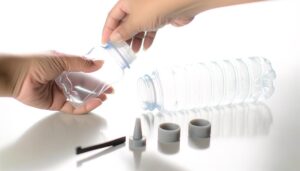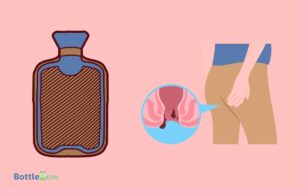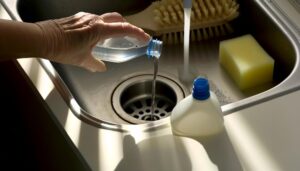Can Bacteria Grow in Water Bottles? Yes!
Yes, bacteria can grow in water bottles, especially under conditions like warmth and inadequate cleaning. Exposure to sunlight promotes algal growth, which provides nutrients for bacteria.
Organic residues from food or skin contact can also feed bacteria. Even sealed bottles aren’t immune, as some bacteria survive in low-nutrient environments.
Contaminated water can cause gastrointestinal and respiratory infections, making proper cleaning and storage vital. Use hot, soapy water daily, and sanitize periodically to maintain a clean bottle.
Now you’re on the brink of exploring essential details about safe drinking practices and effective cleaning tips.
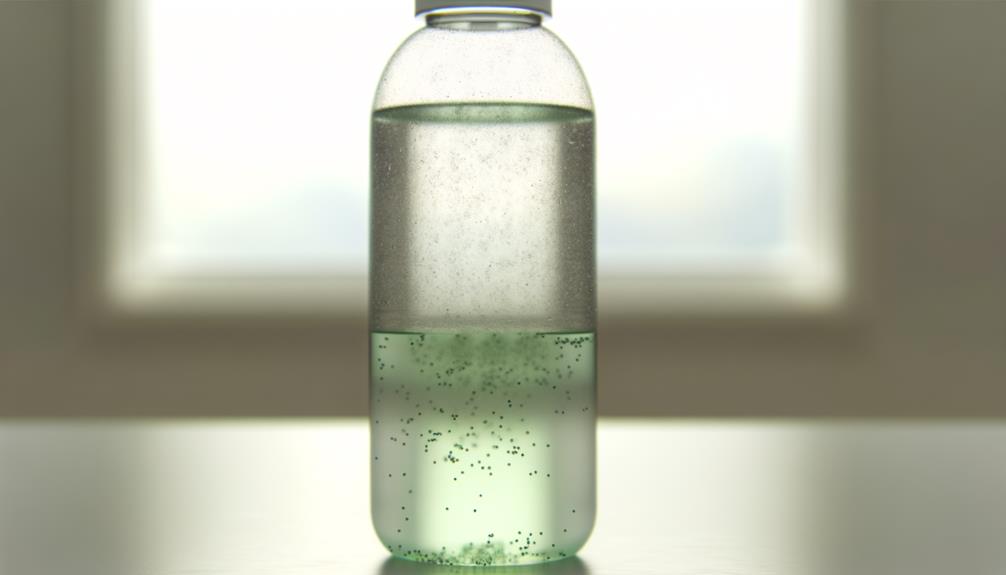
Key Takeaways
- Bacteria can grow in water bottles, especially in warm, nutrient-rich conditions.
- Even sealed bottled water can harbor bacteria due to contamination during bottling or storage.
- Reusable bottles require daily cleaning to prevent bacterial buildup.
- Elevated temperatures and sunlight exposure accelerate bacterial multiplication in water bottles.
Bacteria Growth in Water Bottles – Risks and Prevention
| Risk Factor | Description | Prevention Tips |
|---|---|---|
| Warm, Moist Environment | Bacteria thrive in warm and moist environments like unclean water bottles. | Regularly wash your bottle with soap and warm water to prevent bacteria. |
| Reusable Bottle Use | Frequent use without proper cleaning can lead to bacterial growth. | Clean your bottle daily, especially after each use. |
| Biofilm Formation | A biofilm, a layer of bacteria, can form inside bottles if not cleaned properly. | Scrub the inside surfaces thoroughly with a bottle brush. |
| Mouthpiece Bacteria | Bacteria can accumulate on the mouthpiece, increasing the risk of ingestion. | Clean the mouthpiece regularly and wipe it down after use. |
| Cross-Contamination | Touching the bottle’s spout or lid with dirty hands can transfer germs. | Wash your hands before handling your water bottle. |
| Stagnant Water | Leaving water in the bottle for too long can promote bacterial growth. | Change the water frequently and avoid leaving it stagnant for extended periods. |
| Unfiltered Water | Using unfiltered or contaminated water in the bottle can introduce bacteria. | Always use clean, filtered water and ensure the bottle is dry between uses. |
Bacteria in Bottled Water
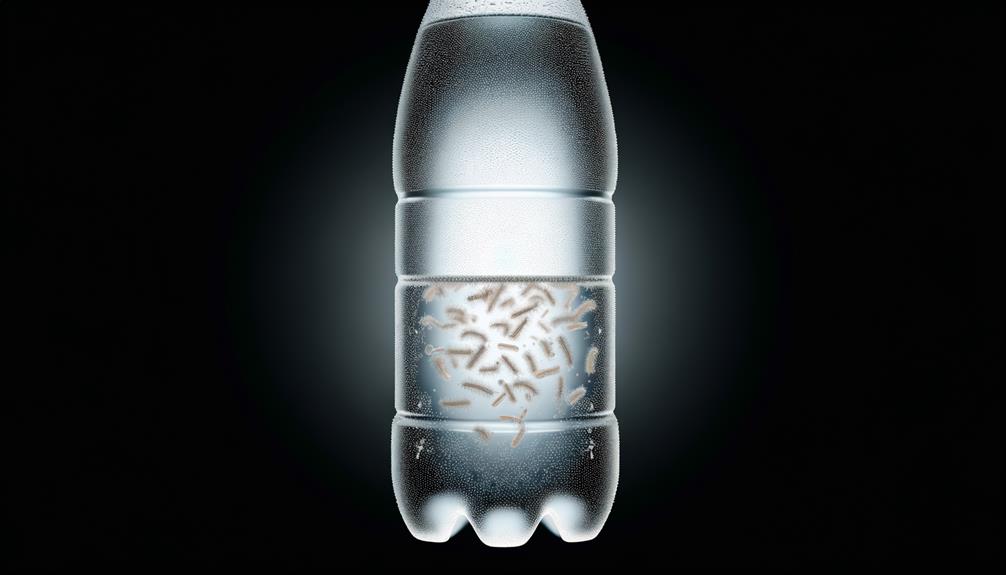
You might be surprised to learn that bottled water can frequently harbor various types of bacteria despite being marketed as a pure and safe alternative to tap water.
Studies have shown that bottled water isn’t always as sterile as you might think. In fact, some brands have been found to contain coliform bacteria, which can indicate contamination and potential health risks.
Additionally, the bottling process and storage conditions can introduce bacteria into the water. Even sealed bottles aren’t immune to bacterial presence, as some types of bacteria can survive and multiply in low-nutrient environments.
It’s crucial to understand that while bottled water often appears cleaner, it doesn’t guarantee a bacteria-free experience. Careful consideration and research into brands can better inform your choices.
Factors for Bacterial Growth
Several key factors contribute to bacterial growth in bottled water, including temperature, light exposure, and the presence of organic or inorganic nutrients.
When water bottles are stored in warm conditions, the elevated temperature creates an ideal environment for bacteria to multiply.
Light exposure, particularly sunlight, can promote algal growth, which in turn provides nutrients for bacteria.
Additionally, even trace amounts of organic matter, such as residues from food or skin contact, can serve as nutrient sources.
Inorganic nutrients, like minerals dissolved in the water, also facilitate bacterial proliferation.
Risks of Contaminated Water
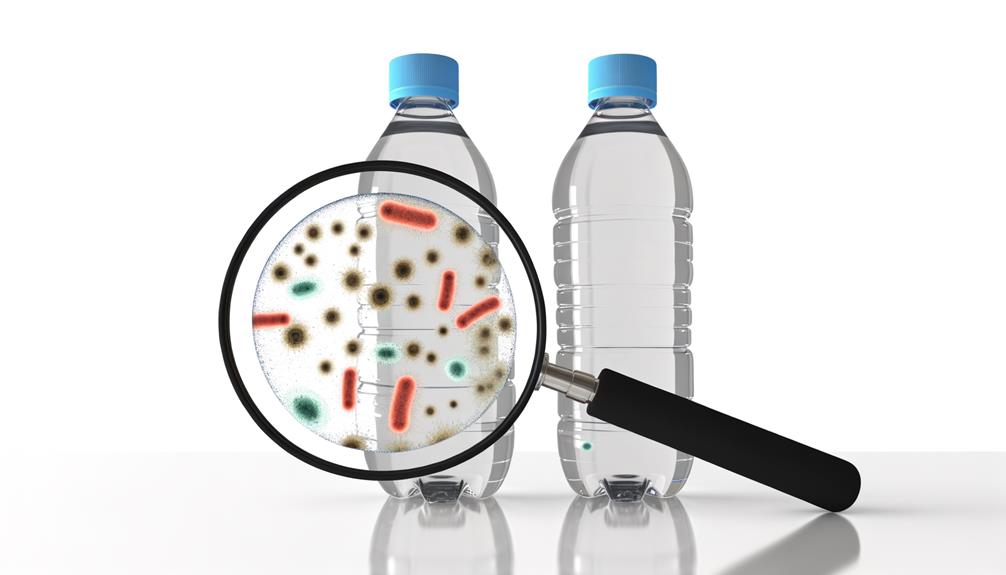
Contaminated water poses significant health risks, including gastrointestinal infections, respiratory issues, and potentially severe diseases like cholera and typhoid fever. When bacteria like E. coli, Salmonella, or Vibrio cholerae contaminate your water bottle, they can multiply rapidly, especially in warm conditions. These pathogens can lead to symptoms ranging from mild stomach cramps to severe dehydration and organ failure. Drinking from a moldy bottle can introduce additional fungi and bacteria into your system, further increasing the risk of infections and allergic reactions. Over time, mold buildup can alter the taste and smell of the water, making it unpleasant and potentially hazardous to consume. Regularly cleaning and properly drying your water bottle can help prevent the growth of these harmful microorganisms.
| Risk | Symptoms |
|---|---|
| Gastrointestinal | Diarrhea, nausea, vomiting |
| Respiratory | Cough, shortness of breath |
| Cholera | Severe diarrhea, dehydration |
| Typhoid Fever | High fever, weakness, abdominal pain |
Understanding these risks underscores the importance of maintaining clean water bottles. Ignoring hygiene can transform your water bottle into a breeding ground for harmful bacteria, directly jeopardizing your health. Always prioritize cleanliness to avoid these serious health issues.
Reusable Vs. Disposable Bottles
When considering reusable versus disposable bottles, you need to weigh their environmental impact, cleaning and maintenance requirements, and overall cost and longevity.
Reusable bottles often have a lower environmental footprint but demand regular and thorough cleaning to avoid bacterial buildup.
In contrast, disposable bottles might seem convenient, but they can lead to higher long-term costs and significant environmental waste.
Environmental Impact Comparison
While reusable water bottles greatly reduce plastic waste, their environmental benefits depend largely on the frequency of their use and proper maintenance.
You must use a reusable bottle multiple times to offset the resources consumed during its production. For example, a stainless steel bottle might need hundreds of uses to break even with the environmental impact of disposable plastic bottles.
On the other hand, disposable bottles contribute considerably to pollution and landfill waste, causing long-term environmental harm.
By choosing and consistently using a reusable bottle, you can considerably lower your carbon footprint.
However, improper care of reusable bottles can lead to quicker replacement needs, diminishing their environmental advantages.
Make informed choices to truly benefit the planet.
Cleaning and Maintenance
Properly cleaning and maintaining reusable water bottles is essential to prevent bacterial growth and guarantee safe drinking water.
You should wash your bottle daily with hot, soapy water. Pay special attention to the cap and mouth area, which are often breeding grounds for bacteria. Regularly use a bottle brush to reach all interior surfaces. Additionally, consider periodic sanitizing with a diluted bleach solution or by running the bottle through the dishwasher if it’s dishwasher-safe.
In contrast, disposable water bottles aren’t designed for repeated use. Their thin plastic can harbor bacteria in scratches and crevices, making thorough cleaning nearly impossible.
For health reasons, it’s best to use disposable bottles only once and then recycle them. This practice minimizes bacterial contamination.
Cost and Longevity
After understanding the importance of proper cleaning and maintenance, let’s examine the cost-effectiveness and longevity of reusable versus disposable water bottles.
Reusable bottles, often made from stainless steel or BPA-free plastic, have a higher initial cost but can last for years if properly maintained. Over time, they become more economical compared to disposable bottles, which require frequent replacement.
Disposable bottles, typically made from single-use plastics, might seem cheaper upfront, but their recurring costs add up quickly. In addition, disposable bottles contribute considerably to environmental waste.
When considering longevity, reusable bottles generally offer a more sustainable solution, both financially and environmentally. By investing in a durable, reusable bottle, you not only save money but also reduce your ecological footprint.
Cleaning and Maintenance Tips
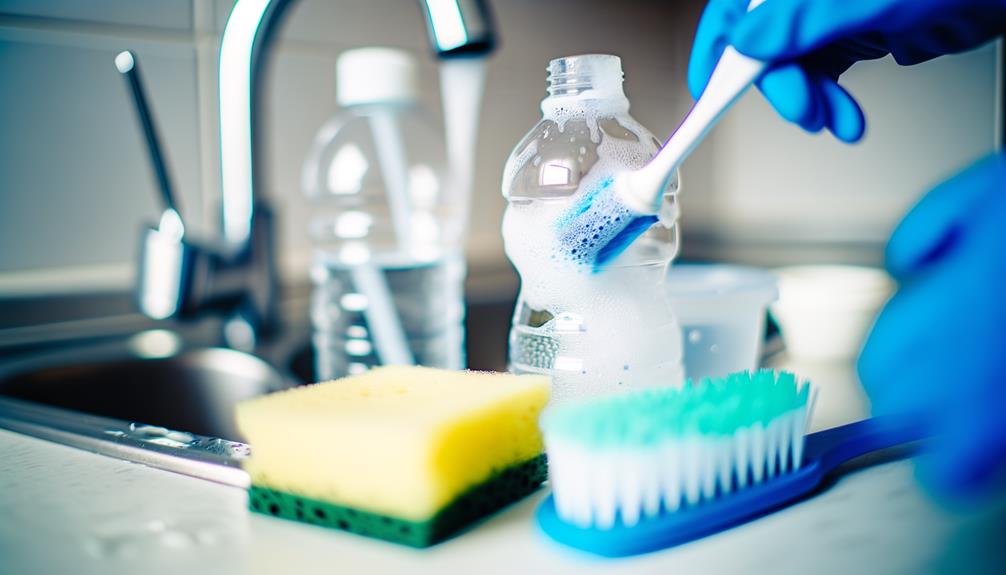
To keep your water bottle free from harmful bacteria, start by thoroughly cleaning it with hot, soapy water on a daily basis.
Make sure you disassemble all removable parts, including the lid and any straws, to reach hidden crevices. Use a bottle brush to scrub the interior surfaces effectively. Rinse thoroughly to remove any soap residues.
For a deeper clean, periodically soak the bottle in a mixture of water and white vinegar or baking soda. Air-dry all components completely before reassembling to prevent moisture buildup, which fosters bacterial growth.
Regular maintenance, including checking for signs of wear and tear, will also help make certain your bottle remains hygienic.
Follow these steps diligently to maintain a clean and safe drinking vessel.
Safe Drinking Practices
Ensuring your water bottle is clean is just the first step; adopting safe drinking practices is equally important to prevent bacterial contamination.
Always wash your hands before handling your bottle. Avoid touching the bottle’s mouthpiece with your hands or mouth. Use clean water sources to fill your bottle, and don’t share your bottle with others.
If your bottle has a straw or a mouthpiece, clean it thoroughly after each use. Store your bottle in a cool, dry place when not in use to inhibit bacterial growth.
Pay attention to the bottle’s material; some plastics can harbor bacteria more easily than stainless steel. Regularly inspect your bottle for any signs of wear that might compromise its cleanliness.
Conclusion
Think of your water bottle as a garden. Without proper care, weeds (bacteria) will thrive.
Just as you’d tend to your garden, you must clean and maintain your bottle. Neglecting this allows harmful bacteria to flourish, posing health risks.
Whether you prefer reusable or disposable bottles, the key is diligence.
By practicing safe drinking habits and regular cleaning, you make certain that your ‘garden’ remains a safe place for hydration, free from unwanted ‘weeds.’


